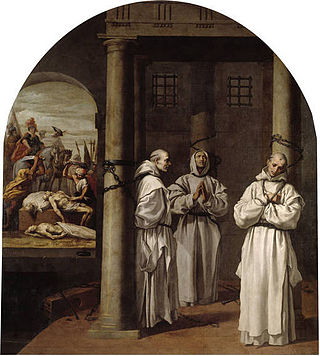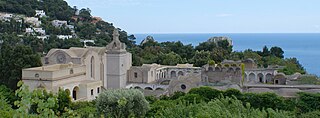
Farneta Charterhouse, in Italian Certosa di Farneta (also Certosa di Santo Spirito di Farneta or Certosa di Maggiano) is a Carthusian monastery (charterhouse) just north of Lucca, region of Tuscany, Italy. [1]

Farneta Charterhouse, in Italian Certosa di Farneta (also Certosa di Santo Spirito di Farneta or Certosa di Maggiano) is a Carthusian monastery (charterhouse) just north of Lucca, region of Tuscany, Italy. [1]
The charterhouse was founded in the early 14th century. In the 17th century, the painters Giovanni Fondagna and Stefano Cassiani worked on the interior of the church, including the cupola and two altar-pieces. [2] The monastery was suppressed by Napoleonic forces in 1809, only to be re-occupied later in the 19th century. [3]
In September 1944, monks from the charterhouse opened their doors to troops from the 16th SS Panzergrenadier Division, who said they came bearing gifts for the abbey. They broke into the monastery to arrest 32 partisans and Jews being sheltered in the monastery. Some of the refugees were able to escape. Six monks and six lay brothers were arrested, tortured, and killed by firing squad.
A plaque at the entrance of the monastery, dedicated on 20 January 1985, nearly four decades after the event, reads:
Forty years after the Liberation the Association of the Resistance Fighters in Lucchesia and the Municipal Authorities of Lucca remember the martyrdom of six Carthusian fathers, six Carthusian brothers and thirty-two civilians in September of 1944. Nazi savagery imposed the same death both on the monks and on those who at the darkest hour had found brotherly hospitality in these sacred precincts. The presence of the Prime Minister at the inauguration of this memorial stone ensures the entry into the history of the Italian people of the witness of these victims. Charterhouse of Farneta, January 20, 1985. [4]
Among the twelve Carthusians killed were two Germans, one Swiss, one Venezuelan, and one Spaniard. The remaining monks were also from diverse countries. Those killed were Benedetto Lapuente, Bruno D'Amico, Raffaele Cantero, Adriano Compagnon, Adriano Clerc, Michele Nota, Giorgio Maritano, Pio Egger, Martino Binz, Gabriele Maria Costa, Salvador Montes de Oca, and Aldo Mei. It is said that when the refugees asked for asylum, the prior Dom Martino Binz consulted with the procurator Dom Gabriele Costa, and the novice master Dom Pio Egger. Binz stated:
If it were Jesus himself knocking at the door, what would we tell him? Would we have the courage to send him off to die?
They opened the door. [4]
After the war, the monks remained silent about the execution. In 2000 the Holy See requested a report from the monks, to be sent to the Commission of the New Martyrs. Journalist Luigi Accattoli was the first person external to the Commission who read the report and in 2014 published the book La strage di Farneta - The Farneta Massacre -. [5]

The Carthusians, also known as the Order of Carthusians, are a Latin enclosed religious order of the Catholic Church. The order was founded by Bruno of Cologne in 1084 and includes both monks and nuns. The order has its own rule, called the Statutes, and their life combines both eremitical and cenobitic monasticism. The motto of the Carthusians is Stat crux dum volvitur orbis, Latin for "The Cross is steady while the world turns". The Carthusians retain a unique form of liturgy known as the Carthusian Rite.

The Carthusian Martyrs of London were the monks of the London Charterhouse, the monastery of the Carthusian Order in the City of London who were put to death by the English state in a period lasting from the 4 May 1535 until the 20 September 1537. The method of execution was hanging, disembowelling while still alive and then quartering. Others were imprisoned and left to starve to death. The group also includes two monks who were brought to that house from the Charterhouses of Beauvale and Axholme and similarly dealt with. The total was 18 men, all of whom have been formally recognized by the Catholic Church as martyrs.

The Certosa di Pavia is a monastery complex in Lombardy, Northern Italy, situated near a small village of the same name in the Province of Pavia, 8 km (5.0 mi) north of Pavia. Built from 1396 to 1495, it was once located at the end of the Visconti Park a large hunting park and pleasure ground belonging to the Visconti dukes of Milan, of which today only scattered parts remain. It is one of the largest monasteries in Italy.
Certosa is an Italian word meaning Carthusian monastery, or charterhouse. It may refer to:

Padula is a comune in the province of Salerno in the Campania region of south-western Italy. It is the home of the Carthusian monastery Certosa di San Lorenzo, sometimes referred to as the Certosa di Padula. As of 2011 its population was of 5,279.

The Certosa di San Martino is a former monastery complex, now a museum, in Naples, southern Italy. Along with Castel Sant'Elmo that stands beside it, this is the most visible landmark of the city, perched atop the Vomero hill that commands the gulf. A Carthusian monastery, it was finished and inaugurated under the rule of Queen Joan I in 1368. It was dedicated to St. Martin of Tours. During the first half of the 16th century it was expanded. Later, in 1623, it was further expanded and became, under the direction of architect Cosimo Fanzago, essentially the structure one sees today.

Florence Charterhouse is a charterhouse, or Carthusian monastery, located in the Florence suburb of Galluzzo, in central Italy. The building is a walled complex located on Monte Acuto, at the point of confluence of the Ema and Greve rivers.

Pisa Charterhouse, also Calci Charterhouse or Val Graziosa Charterhouse, is a former Carthusian monastery, now the home of the Pisa Museum of Natural History. It is 10 km outside Pisa, Tuscany, Italy, in the comune of Calci.
Gorgona Abbey, later Gorgona Charterhouse, was a monastery on the small island of Gorgona in the Mediterranean between Corsica and the coast of Tuscany. It was abandoned in 1425. The remnants of the Abbey's ground are now part of the Gorgona Agricultural Penal Colony.

The Certosa di Bologna is a former Carthusian monastery in Bologna, northern Italy, which was founded in 1334 and suppressed in 1797. In 1801 it became the city's Monumental Cemetery which would be much praised by Byron and others. In 1869 an Etruscan necropolis, which had been in use from the sixth to the third centuries BC, was discovered here.

Garegnano Charterhouse, also known as Milan Charterhouse is a former Carthusian monastery, or charterhouse, located on the outskirts of Milan, Italy, in the Garegnano district. It now houses a community of Capuchin Friars.

Certosa di San Giacomo was a Carthusian monastery, founded in 1363 by Giacomo Arcucci on the island of Capri, Campania, southern Italy. It is now a museum and is used for cultural events. The buildings that formed the charterhouse have three main areas: the pharmacy and women's church, the buildings for monks, and those for guests. The cloister is of a late Renaissance design, while the Chiostro Piccolo features Roman marble columns.

Montebenedetto Charterhouse is a former Carthusian monastery in the Val di Susa in Piedmont, Northern Italy.

The Carthusian martyrs are those members of the Carthusian monastic order who have been persecuted and killed because of their Christian faith and their adherence to the Catholic religion. As an enclosed order the Carthusians do not, on principle, put forward causes for their members, though causes have been promoted by others on their behalf.

Trisulti Charterhouse is a former Carthusian monastery or charterhouse, now owned by the Cistercians, in Collepardo, province of Frosinone, central Italy. It is located on the slopes of Monte Rotonaria, a peak of the Monti Ernici, at 825 meters above sea level. It was consecrated in 1211, becoming a national monument in 1873.

Ferrara Charterhouse, of which the present Church of San Cristoforo alla Certosa was previously the monastic church, is a former charterhouse or Carthusian monastery built in Renaissance style, located on Piazza Borso 50 in Ferrara, Region of Emilia-Romagna, Italy. The monastery was suppressed in the time of Napoleon, but the church was reconsecrated in 1813 and remains in use. The site also accommodates a large municipal cemetery, which was established in 1813.

The Certosa di Pontignano, also known as the Certosa di San Pietro, is a Carthusian monastery and church in the neighborhood of Pontignano, within the town limits of Castelnuovo Berardenga, a few kilometers north of the city of Siena, in the region of Tuscany, Italy. The monastic complex, after the expulsion of the monks in 1810, passed through various hands, until it was acquired in 1959 by the University of Siena, and used for academic meetings, conventions, and also hotel and restaurant for events such as weddings and celebrations.

Antonio Surian was Patriarch of Venice from 1504 to his death.